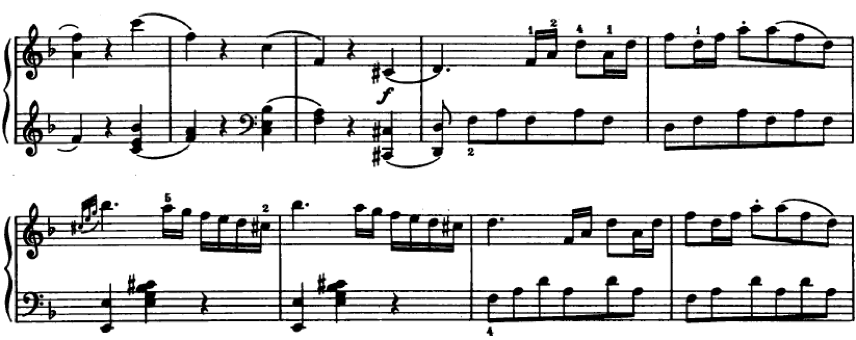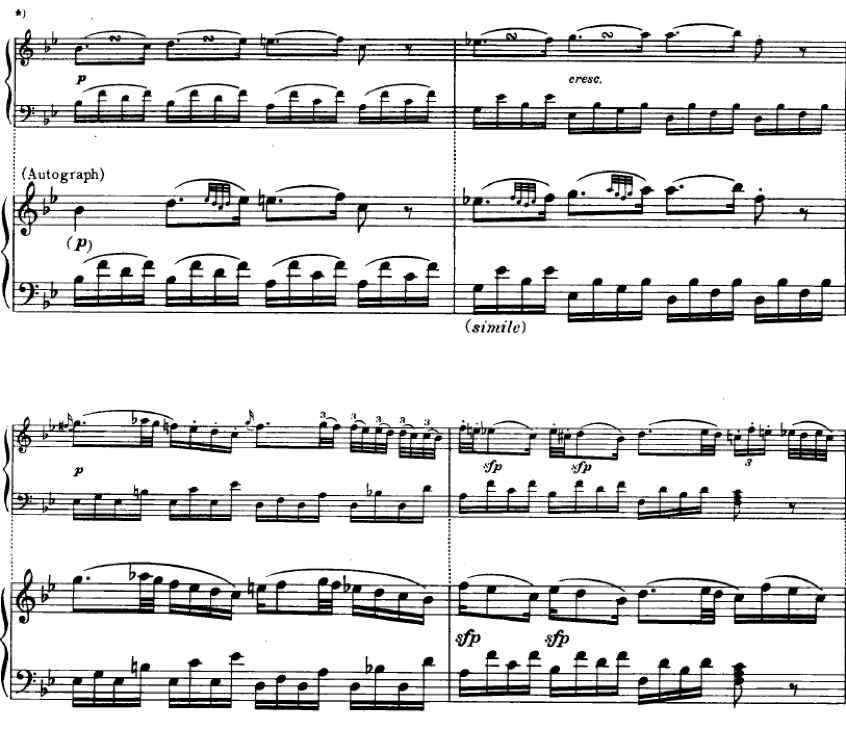Teaching Piano Students to Pedal, Part VI: Finger Pedalling

In this series of articles, I’ve focused on helping students discover the indications various composers employed to show where they wanted the sustaining pedal engaged and released. What happens when our ears want additional resonance from the instrument, but using the pedal would obscure a melodic line or cover a required silence? This is the time when a technique known as Finger Pedalling can be helpful.
Finger Pedalling creates some of the additional resonance we seek from the foot pedal without actually using the pedal; we sustain the bass notes of harmonies with our fingers, giving the impression that pedal is being used, but without causing any undesired confusion in other parts of the musical texture. This holding down of bass notes is not to be confused with the bad habit of over-holding keys due to a lack of independence of the fingers. Our students must already have achieved the independence required to release keys when moving on to subsequent tones. Only after they’ve mastered this skill through scale practice and other technical training can they be shown how to sustain bass notes separately from other accompaniment patterns.
The technique of holding some notes longer than other moving voices pre-dates the invention of the piano. This was necessary for creating the contrapuntal lines of Baroque music. Bach would often notate which tones were to be sustained, as in this example from Volume 1 of the Well-Tempered Clavier:

The double-stemmed notes would be held as the sixteenth notes are played.
There are times when motivic ideas are embedded inside moving lines without double stems to distinguish them. In these instances, a harpsichordist may choose to highlight the motivic idea by sustaining the notes longer than their written value, thus creating a separation between the motivic material and the moving notes surrounding it.
In the following example from Bach’s French Suite #5 in G Major we see an idea introduced on the first beat of the 2nd complete measure: the stepwise descending idea in the lower part of the right-hand notes. That descending motive is alternating with repeated G’s above the staff. The idea is restated in the 3rd measure, developed in the 7th, and inverted in the 10th. Sustaining the moving notes with the finger makes this motivic development clear and audible.

In Classical Period music it was bass notes that were commonly held with the finger. We know from the writings of Mozart’s students that he often held the lowest notes in Alberti Bass and other broken-chord patterns, even when those notes were not marked with double stems or other indications to sustain them.
Our reliable friend Czerny has many exercises to introduce this concept to young students. Here are a few examples from the Opus 823 collection:



In all these examples Czerny specifies that basses are to be held, either through the use of double-stemmed notes or the whole notes in the 2nd example. Later in the same volume he stops adding these sustained notes, expecting, in my view, that students will continue to hold bass notes.
We find a broken-chord accompaniment at the opening of Mozart’s G Major Sonata, K. 283. If we sustain the notes only as long as written, the effect is dryer than many of us find satisfying. Attempting to increase the warmth and resonance by using the pedal causes sound to bleed into the rests, which wouldn’t be appropriate in this style. Finger pedalling is the solution that allows us to respect the rests in the right hand while also adding resonance that warms the sound. In addition, it creates a duet between the melody and the bass line.

A similar contrapuntal effect can be created later in the same movement by sustaining the lower notes of the left hand. This example makes clear how the technique evolved from Baroque practice.

We can hear the sustained bass notes of both of the above examples in this sparkling performance of the sonata by Alicia de Larrocha:
Another Mozart Sonata, the F Major, K. 332, also presents an opportunity to employ finger pedalling to highlight the bass notes of each harmony and to create counterpoint with the melody.

Later in the same movement we see the following example. In the final measure of the first line we need to hear the staccato of the right-hand A. Using the pedal would hide the staccato, so here is another place where sustaining the bass with our finger allows us to continue hearing the harmony while also articulating the melody as indicated.

In the following two examples from the beautiful second movement of the same sonata we find more places where finger pedalling is of great help. The melodic lines become increasingly florid through this movement, with requirements for ornaments, two-note slurs, staccatos, and the like, all of which would be blurred by using pedal. The warmth and harmonic clarity provided by sustaining the bass notes support the decorations Mozart offers us in this movement.


We can hear as well as see finger pedalling in this second movement in this expressive performance by Seong-Jin Cho. Starting at the 35-second mark one finds a clear view of his left hand sustaining the bass notes.
We also find opportunities to use finger pedalling in Beethoven’s music. Starting in measure 24 of the following example, taken from the third movement of the Pathétique Sonata, Op. 13, we see a broken-chord accompaniment under a moving melody. Just as in the Mozart example above, using the pedal would obscure the melody as well as change the character of the separate quarter notes in m. 27.

Even when pedal is used, sustaining bass notes can still be useful. We know from Czerny’s words about Beethoven as well as the writings of Chopin’s students that their teachers held bass notes frequently. Doing so meant that the foot could change more frequently without losing the bass notes, or that a lighter pedal could be used which would offer more clarity in melodic lines. An example of the latter idea can be seen in this Etude from Chopin’s Opus 25 collection.

While there is no indication to sustain the bass notes with the finger, the performance below by prize-winning pianist Lukas Geniušas will show the benefit of doing so. At the 30-second point in this video there is a clear view of the pianist holding the bass notes. Because he does this, he’s able to play with the pedal only barely depressed, creating a lightness and clarity that are commendable.
Careful use of the pedal is one of the most important skills we can impart to our students. Sometimes knowing when not to use the pedal is just as valuable. Mastering finger pedalling makes this option available to our students.





